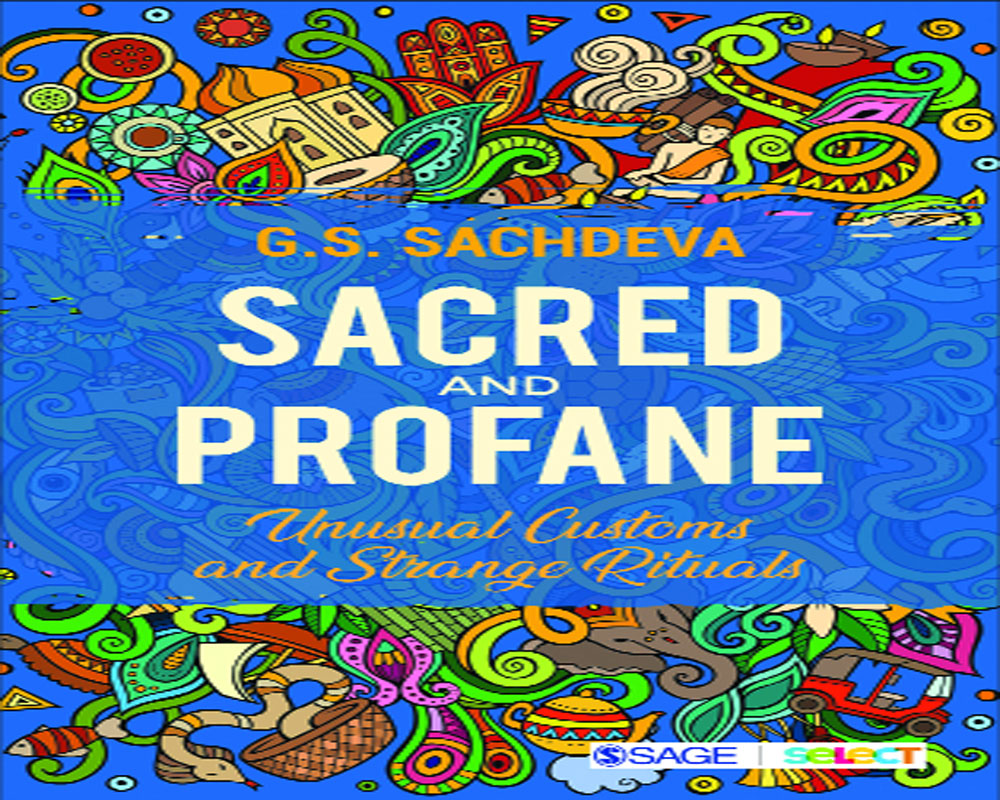Name: Sacred and Profane: Unusual Customs and Strange Rituals
Author: GS Sachdeva
Publisher: SAGE Select, Rs 495
Sacred and Profane by GS Sachdeva is a secular take on the world’s most unorthodox and mystifying rituals, customs and traditions. An edited excerpt:
In the evolution of human society and community living, religion, however primitive, elemental or minimalistic, has always had a place in some form or manner. Even aboriginal and tribal denominations had pseudo-religious totemic faiths, which many of them still carry with staunch fervour. Religion, for them, had a different meaning and purpose in life. It was more relevant to mundane things in life like warding off adversity, ill-luck, illness, etc. For some, religion was a shield against natural calamities like droughts and floods, earthquakes or volcanic eruptions. Religion, to this effect, treated everything incomprehensible as a god and worshipped it to propitiate for benevolence. Later, religion came to be sought and followed for higher virtues, spiritual values, after-life treatment and salvation from rebirth.
Religion has evolved with time as few spiritually enlightened beings were blessed with unique reverential experiences and divine revelations, which were interpreted differently by different groups of people, with shifting of emphasis on traditional tenets and prevalent rituals. As a result, small groups tended to branch off as separate religious sects with differential beliefs and varied pronouncements on attendant rituals. Gradually, these break-away branches developed their own tenets and conspicuous identities with separate prayer systems and anomalized ritualistic practices that came to be recognized as distinct from the main religion, acquiring a different name and calling.
The same happened for Sadasuhags. This sect, though originally part of mainstream Hinduism, leaned in a different direction, highlighting a prominent belief that all living persons are the brides of the Eternal God, irrespective of their gender. Thus, they remain brides forever and never get widowed because God is immortal and eternal. With this cognition and motivation, they dress as women, embellish themselves in feminine ways and mentally pray to please God, imagining him as the groom. With passage of time and growing disapprobation of cross-dressing by the prudish society, this sect went into hiding and has gradually disappeared. These days, few Sadasuhags are seen, either near temples or seeking alms.
Besides, social customs, at times, acquire oddities and unusual practices and turn into superstitions that defy common logic, where optical physicality tends to be illusory or remains unexplained in rational terms; for example, the Koovagam festival of transgenders, the weeping statue, prejudice against the number thirteen or the Spanish festival of Devil's Jump. While some oddities may be backed by reason like exaltation of pigs for economic necessity or the seasonal facts related to the Lenten Moon or Montanna for social justice. […]
Koovagam Festival of Transgenders in Tamil Nadu
Koovagam is the time and place, when and where transgenders flaunt their uniqueness and sexuality in style without any fear of prejudice or stigma. Koovagam, a little-known village in Villupuram district of Tamil Nadu, hosts the biggest festival for the third gender or eunuchs, called Aravanis in Tamil. This festival lasts for one week and is celebrated with big rallies, beauty pageants, sports events, gala feasts and other festivities. People from the transgender community also tie nuptial knots with a deity at the local Koothandavar temple and freely consummate their marriage in the open fields under a full moon sky. The final day of the week-long celebrations falls on a full moon night in April, every year.
Legend has it that Lord Krishna turned into Mohini, a beautiful woman, to marry a local boy, Aravan, for a night. This was because Aravan was to be sacrificed the next morning during the Kurukshetra war and no woman had come forward to tie the knot. Lord Krishna blessed him with this bliss of marital pleasure. The eunuchs, called Aravanis in Tamil Nadu, assume the role of Mohini every year and marry the legendary Aravan at the Koothandavar temple in a hallowed tradition.
The euphoric celebration has been accepted so far as an age-old practice, but has been condemned in the recent times, since the morning after the consummation of ritualistic marriage, the fields look like dump yard of condoms, which are often, in amusement, picked up by young children to the embarrassment of the parents and possibly constitute a bad influence on them. It has been seen lately that sex workers, homosexuals, bi-sexuals, bi-curious and even cross-dressers enter the fest and boldly mingle with their cognate peers.
Besides, many seem in unusual hurry to have multiple sex escapades during this licentious time. This has vitiated the solemn environment and local resistance to the festivities is growing. In any case, the present message being propagated is 'No sex around the temple'. This is how traditions are debased to attract a stigma.
An excerpt from Sacred and Profane: Unusual Customs and Strange Rituals by G. S. Sachdeva, published by SAGE Publications India


























